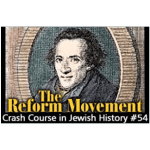History Crash Course #39: The Talmud
At various times during the Hadrian persecutions, the sages were forced into hiding, though they managed to reconvene at Usha in 122 CE, and then in a time of quiet managed to re-establish again at Yavneh in 158 CE.
With so much persecution and unrest, with the Jewish people fleeing the land of Israel, the rabbis knew that they would not be able to keep a central seat of rabbinic power alive for long.
Yet, during these great periods of chaos, some of the finest rabbinic minds made their mark. Among them:
- Rabbi Akiva (whom we discussed in Part 38)
- Rabbi Akiva’s chief disciple, Rabbi Meir, also the husband of the legendary Bruriah
- Rabbi Shimon Bar Yochai, the author of the Zohar, the central text of the Kabbalah
- Rabbi Shimon Bar Yochai’s son, Rabbi Eliezer
- Rabbi Shimon Ben Gamliel II, the descendant of the House of Hillel and a direct descendant of King David
Yehudah HaNasi
Now, another man was to emerge and make his mark ― the son of Rabbi Shimon Ben Gamliel II ― Rabbi Yehudah HaNasi (in English “Judah, the Prince”).
In a time of chaos, the rabbis decide that they must do the unprecedented ― write down the Oral Law.
He is one personality who is absolutely fundamental to understanding this period of time, and one of the greatest personalities of Jewish history.
So great was he that he is now affectionately referred to in Jewish scholarship as only Rebbe.
He had a unique combination of attributes ― being both a great Torah scholar and a strong leader ― that gave him the power to lead the Jewish people at this chaotic time. He was also a man of tremendous personal wealth, which put him in a position to wheel and deal and do what needed to get done, not just with the Jews in the Land of Israel but with the Roman authorities as well.
Hadrian dies in 139 C.E and with his death came an improvement in the treatment of the Jewish community in Israel. During a period of relative quiet, Rabbi Yehudah HaNasi managed to befriend the Roman emperors who succeeded Hadrian, particularly Marcus Aurelius (161-180 C.E.). Writes historian Rabbi Berel Wein in his Echoes of Glory (p. 224):
Providentially, in the course of the Parthian war, Marcus Aurelius met Rabbi [Yehudah HaNasi], and they became friends and eventually confidants. Marcus Aurelius consulted with his friend in Judah on matters of state policy as well as on personal questions.[1]See Talmud ― Avodah Zara 10a-b; Breishit Rabbah 67:6; 75:5The years of Marcus Aurelius’ reign, ending in his death in 180, was the high-water mark in the intercourse between Rome and the Jews. The Jews, under the leadership of Rabbi [Yehudah HaNasi], would use this period of blissful respite to prepare themselves for the struggle of darker days surely lurking around the corner.
At this time ― circa 170-200 CE ― the Mishnah was born.
Mishnah
What is the Mishnah?
In past installments we discussed the fact that at Mount Sinai the Jewish people received the Written Torah and the Oral Torah. The Oral Torah was the oral explanation of how the written laws should be executed and followed.
The Oral Torah passed from generation to generation and was never written down[2]See Midrash Tanchuma ― Ki Tisa 34; Talmud ― Gittin 60a;. Why? Because the Oral Torah was meant to be fluid. The principles stayed the same, but the application of those principles was meant to be adapted to all types of new circumstances.
This worked exceptionally well as long as the central authority ― the Sanhedrin ― remained intact, and the chain of transmission was not interrupted. (That is, teachers were able to freely pass on their wisdom to the next generation of students.) But in the days since the destruction of the Temple, the Sanhedrin had been repeatedly uprooted and teachers had to go into hiding.
Rabbi Yehudah HaNasi realized that things would not get better any time soon. He saw that the Temple would not be rebuilt in his generation and possibly in many generations to come. He saw the Jews fleeing the land as a result of the constant persecutions and impossible living conditions. He saw that the central authority was weaker than ever and might cease altogether To make sure that the chain of transmission would never be broken, he decided that the time had come to write down the Oral Torah.[3]For a detailed explanation of actions of Rebbi Yehuda HaNasi see Maimonides, Introduction to Mishneh Torah. See also Iggerot of Rabbi Sheriram Gaon 1:1.
This was a mammoth undertaking. Although much of the work may have already been done by previous generations of rabbis, the monumental task of editing, explaining and organizing this vast amount of material was left to Rabbi Yehudah. The end result of this massive undertaking was a definitive, yet cryptic (the basic principles were all there yet a teacher was still required to elucidate the material) version of the entire Oral Law called the Mishnah. (Incidentally, the wordMishnah means “repetition” because it was studied by repeating; Mishnah then, by extension, means “learning.”) Maimonides, in his introduction to his Mishneh Torah, explains it as follows:
He gathered together all the traditions, enactments, and interpretations and expositions of every position of the Torah, that either come down from Moses, out teacher, or had been deduced by the courts in successive generations. All this material he redacted in the Mishnah, which was diligently taught in public, and thus became universally known among the Jewish people. Copies of it were made and widely disseminated, so that the Oral Law might not be forgotten in Israel
Six Categories of Jewish Law
The Mishnah, which is written in Hebrew, is divided into six basic segments or “orders” and further subdivided into 63 tractates with a total of 525 chapters. These 6 segments dealing with six basic areas of Jewish law:
- Zeraim, literally “seeds,” covering all agricultural rules and laws for foods as well as all blessings
- Moed, literally, “holiday,” dealing with the rituals of Shabbat and other Jewish holidays
- Nashim, literally “women,” examining all the issues between men and women such as marriage, divorce, etc.
- Nezikin, literally “damages,” covering civil and criminal law
- Kodshim, literally “holy things,” concerning laws of the Temple
- Taharot, literally “pure things,” concerning laws of spiritual purity and impurity
Rabbi Yehudah HaNasi finished the Mishnah in ca. 190 CE in the town of Tzipori in the Galilee. You can visit the site today which is very interesting from an archeological perspective. At a site called Beit She’arim (where the Sanhedrin had previously been located prior to its move to Tzipori), there is a vast number of burial caves carved into the side of a mountain. Based on evidence found at the site, archaeologists believe that one of these caves contains the grave of Rabbi Yehudah HaNasi, along with many other great scholars of that time.
Not long after the death of Rabbi Yehuda HaNasi the period know as the era of the Tannaim came to a close. The term Tanna, is derived from the Aramaic word “to teach” and covered a period of 200 years from ca.10 B.C.E. to 200 C.E. beginning with Rabbi Shimon the son of Hillel the Elder and ending with Rabbi Yossi ben Yehuda.
Writing The Talmud
During the centuries following the completion of the Mishnah, the chain of transmission of the Oral law was further weakened by a number of factors: Economic hardship and increased persecution of the Jewish community in Israel caused many Jews, including many rabbis, to flee the country. Many of these rabbis emigrated to Babylon in the Persian Empire. The role of the rabbis of Israel as the sole central authority of the Jewish people was coming to an end.
This decentralization of Torah authority and lack of consensus among the rabbis led to further weakening of the transmission process. It became clear to the sages of this period that the Mishnah alone was no longer clear enough to fully explain the Oral Law. It was written in shorthand fashion and in places was cryptic. This is because it was very concise, written on the assumption that the person reading it was already well-acquainted with the subject matter.
So they began to have discussions about it and to write down the substance of these discussions.
Since at this time a significant portion of the Jewish population was living in Babylon, which was outside the bounds of the Roman Empire, the rabbis there put together their discussions, the end product of which was called Talmud Bavli or the Babylonian Talmud. Even before this process had begun in Babylon, in the land of Israel, another set of discussions took place and the end result was Talmud Yerushalmi or the Jerusalem Talmud. (Incidentally, the Jerusalem Talmud was not written in Jerusalem; it was written in Tiberias, the last place where the Sanhedrin sat, but was called the Jerusalem Talmud in deference to the Sanhedrin’s rightful home.)
Due to persecution of the Jewish community in Israel the Jerusalem Talmud, completed in the mid 4th century C.E., was never completed or fully edited. The Jerusalem Talmud is much shorter (it contains only four of the six sections of the Mishnah[4]The Baylonian Talmud covers tractates: Moed, Nashim, Nezikin and Kodshim, while the Jerusalem Talmud covers tractates Moed, Nashim, Nezikin and Zeraim.) and is more cryptic and harder to understand than the Babylonian Talmud. The situation of the Jews in Babylon was much more stable and the rabbis in Babylon had considerably more time to edit and explain the subject matter.
Although there are two Talmuds, they are not really separate. The Rabbis of Babylon had access to the Jerusalem Talmud while they were working on their text. But if there is dispute between the two Talmuds, the Babylonian Talmud is followed.[5]See Rif on Talmud ― Eruvin 35b Both because Babylonian Talmud is considered more authoritative and the Jerusalem Talmud is more difficult to study, Jewish students pouring over the Talmud in yeshiva are using chiefly the Babylonian Talmud. The Talmud is more than just an application of the details of the Jewish law as expounded in the Mishnahh. It’s the encyclopedia of all Jewish existence.
The Talmud also contains a lot of agadata ― these are stories that are meant to illustrate important points in the Jewish worldview. These stories contain a wealth of information on a huge range of topics. you name it, it’s in there.
This information was vital to the Jewish people because Jewish law was never applied by reading a sentence in the Torah and executing it to the letter. Take for example, “eye for an eye, tooth for a tooth.” It was never Jewish law that if someone blinded you, that you should go and blind him. What is the good of having two blind people? It was always understood on two levels: 1) that justice must be proportional (it’s not a life for an eye) and 2) that it means the value of an eye for the value of the eye, referring to monetary damages. Thus, the Talmud presented the written and oral tradition together.
To read the Talmud is to read a lot of arguments. On every page it seems that the rabbis are arguing. This kind of argument ― the purpose of which was to arrive at the kernel of truth ― is called pilpul. This word has a negative connotation outside the yeshiva world, as people read these arguments and it seems to the uneducated eye that the rabbis are merely splitting hairs, and that some of the arguments have absolutely no basis in everyday life. But this is not so.
The reason why the rabbis argued about things that may not have any application to everyday life was to try to get to truth in an abstract way – to understand the logic and to extract the principle. These rabbis were interested in knowing what reality is and in doing the right thing. Reality is what Judaism is all about ― the ultimate reality being God.
Another important point is that much of the discussion and dispute is focused on relatively minor points while the larger issues are generally not disputed. You don’t see a single argument as to whether or not you eat pork, or whether or not you can light a fire on the Sabbath. These things were a given, they were totally agreed upon. Only small points were subject to discussion. And these rabbis were wise enough to know that a day would come when the principles established by getting to the core kernel of truth would have far reaching implications.
Gemara
When you look at the page of the Babylonian Talmud today, you will find the Hebrew text of the Mishnah is featured in the middle of the page. Interspersed between the Hebrew of the Mishnah are explanations in both Hebrew and Aramaic which are called the Gemara.
The Aramaic word Gemara means “tradition.” In Hebrew, the word Gemara means “completion.” Indeed, the Gemara is a compilation of the various rabbinic discussions on the Mishnah, and as such completes the understanding of the Mishnah.
The texts of the Mishnah and Gemara are then surrounded by other layers of text and commentaries from a later period.
The text of the Mishnah is quoting rabbis who lived from about 100 BCE to 200 CE. These rabbi are called the Tanaim, “teachers.” In this group are included such greats as Rabbi Yochanan Ben Zakkai, Rabbi Shimon Bar Yochai, Rabbi Akiva, and of course Rabbi Yehudah HaNasi. (In the Gemara, they usually have the title Rebbe before their first name although there are many exceptions such as the names: Hillel, Shamai, Ben Azai and Ben Zoma.)
The text of the Gemara is quoting the rabbis who lived from about 200 CE to about 500 CE. These rabbis are called, Amoraim, “explainers” or “interpreters.” In this group are included Rav Ashi, Reb Yochanan, etc. (Names of the Babylonian Amoraim usually are preceeded by the title Rav as opposed to the Amoraim of Israel who continued to use the title Rabbi/Rebbe. This is because the authentic institution of smicha – rabbinic ordination ― was only done in the Land of Israel.)
The surrounding text of today’s Talmud also quotes Rishonim, literally “the first ones,” rabbinic authorities (from c. 1,000 C.E. until 1,500 C.E.) who predated Rabbi Joseph Caro, the 16th century author of the code of Jewish law known as the Shulchan Aruch. Among the most prominentRishonim are Rashi, his students and descendants who were the chief authors of the Tosafos, Maimonides and Nachmanides. We will discuss the contributions of these rabbis in future installments.
Just how important was the work of Rabbi Yehudah Hanasi and those that followed him would become very clear in the next hundred years when the Jewish people face another threat to their religion. This is when the Roman Empire decides to convert its entire population to Christianity.
References
| ↑1 | See Talmud ― Avodah Zara 10a-b; Breishit Rabbah 67:6; 75:5 |
|---|---|
| ↑2 | See Midrash Tanchuma ― Ki Tisa 34; Talmud ― Gittin 60a; |
| ↑3 | For a detailed explanation of actions of Rebbi Yehuda HaNasi see Maimonides, Introduction to Mishneh Torah. See also Iggerot of Rabbi Sheriram Gaon 1:1. |
| ↑4 | The Baylonian Talmud covers tractates: Moed, Nashim, Nezikin and Kodshim, while the Jerusalem Talmud covers tractates Moed, Nashim, Nezikin and Zeraim. |
| ↑5 | See Rif on Talmud ― Eruvin 35b |










